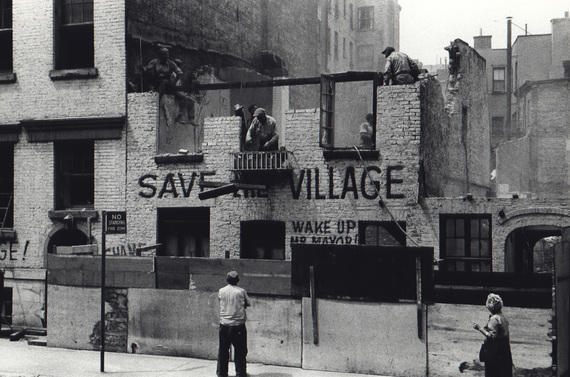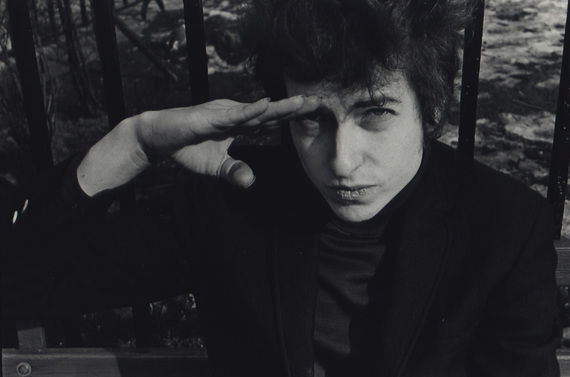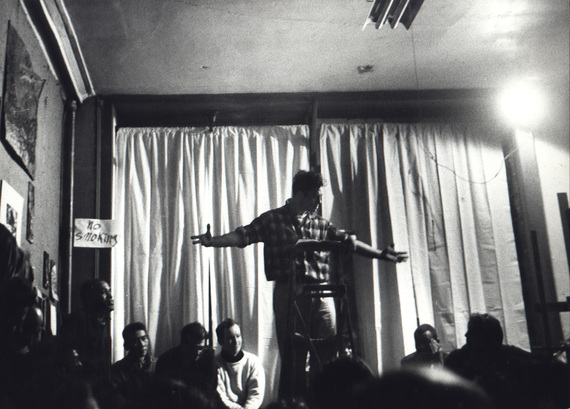Demolition of Artist's Studio, Greenwich Avenue, May 19, 1960
© Estate of Fred W. McDarrah, courtesy Steven Kasher Gallery, New York
Fred McDarrah (1926-2007) looked at Greenwich Village for 50 years and caught what he saw for us all. The Brooklyn-born McDarrah bought his first camera as a teenager, and spent most of his career as a photographer at The Village Voice. His documentary pictures of moments in New York City's history are as iconic as his often spontaneous portraits of artists, writers, musicians, politicians and unknown people on its streets.
Now, McDarrah's photographs of and pertaining to the Village, from the late 1950s through the 1980s, are being shown in an exceptional exhibition at Steven Kasher Gallery in Chelsea. The show opened last Thursday night, and is not to be missed if you're traveling to New York, and particularly not to be missed if you live in New York -- but, imperatively, if you live in and love Greenwich Village.
Fred W. McDarrah: Save the Village takes its name from the words painted on the side of an artist's studio on Greenwich Avenue, being demolished in 1960 and memorably photographed by McDarrah. That Village is already past in too large a part, though its shadows remain in the literary and cultural walking tours that lace the neighborhood. Thanks to organizations like the Greenwich Village Society for Historic Preservation, the depredations of developers today are noticed, protested and increasingly often blocked. Much is gone, but there's still much to be not only remembered, but saved. Ancient footprints are everywhere, from 14th to Houston Streets, and from the Hudson to the East. What you realize as you walk through this show is that McDarrah did save the Village: His images are far more than a chronicle. They themselves now constitute part of both the history and the art being made there in the 1960s, '70s and '80s.
You know McDarrah's cityscapes: The smoking shell of a building on West 11th Street, immediately after the Weatherman bomb factory explosion in 1970; Demonstrators in front of the Stonewall on Christopher Street, June 1969; Washington Square arch at night; Flower children and hippies in the 5th Avenue Mill-In, 1967.
You know McDarrah's portraits even better: A saintly Bobby Kennedy, under a portrait of Jesus crowned with thorns, touring a Lower East Side slum apartment; A holy Allen Ginsberg, cardboard stars-and-stripes top hat perched on his mass of dark curls, demonstrating against the Vietnam War; A patrician John Lindsay, hands on hips, surveys one of the streets in his town; An electric Jack Kerouac in his lumberjack shirt, arms outflung, reading to a rapt audience; A young Bob Dylan, on a bench in Sheridan Square, his lips chapped and his eyes locked clear and farseeing into McDarrah's camera, raises his fingerpicking right hand with its long nails in a salute.
Bob Dylan, Sheridan Square Park, January 22, 1965
© Estate of Fred W. McDarrah, courtesy Steven Kasher Gallery, New York
They're all here, and more. I was surprised, and delighted, to see a portrait of Harold Pinter in three-quarter profile, smoking a thin dark cigarette. In a timely nod to the Coen Brothers' Inside Llewyn Davis -- though it's truer and more appropriate to say the movie is homage to the world McDarrah caught so well -- there is a beautiful photograph of Phil Ochs in mid-song. The later days of the '60s, and 1970s, show in the faces of Elvis in white with long sideburns, Robert Moses, John Lennon relaxing under a tree, Carl Bernstein and Nora Ephron, a pouting Donald Trump, Candy Darling, and Andy Warhol. McDarrah's newspaper, as it once was, is memorialized on one wall of the show: the old Voice offices in Sheridan Square; Nat Hentoff with Tom Morgan; Norman Mailer and Daniel Wolf; Lucian Truscott. McDarrah himself is here too, seen working in the archive, and reading the names on the Yiddish Walk of Fame in front of the 2nd Avenue Deli.
Where the 2nd Avenue Deli once flourished and fed, you may now find a Chase Bank. The Village Voice offices are no longer in Sheridan Square -- or, indeed, in the Village. Candy and Andy, Lennon and Ochs, are gone, all too young. If you want -- if you need -- this world back again, step into the Kasher Gallery now. Many thousand indifferent images of New York City, its politicians and poets, musicians and movers-and-shakers, activists and artists, flood the Internet from cameras and cellphones hourly. If you want to see black-and-white portraits and pictures on the streets, printed when they were taken, with knife-cut lines and light and shadows and all the power of perfect photography, treat yourself to this show.
Jack Kerouac Reading Beatnik Poetry in Lower East Side Loft, February 15, 1959
© Estate of Fred W. McDarrah, courtesy Steven Kasher Gallery, New York
'Fred W. McDarrah: Save the Village' through March 8th, 2014 at Steven Kasher Gallery, 521 West 23rd Street, New York.



